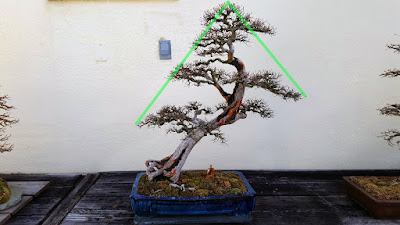Color in bonsai is pretty much straight forward. In bonsai earth tones and greens dominate. Earth tones are the colors you see in dirt. This could be reds, browns, blacks greys, whites and even some yellows. Bonsai may have other color due to flowers, and fruits. Some trees new growth are red and later turns green. Add to that the pots the trees are in and you have a lot of color. So how do we know what color pot to use?
What part of the tree do you want to emphasise? Is it a red berry? Orange leaves in the autumn (called fall in the U.S.)? Is it the bark, leaves, deadwood? Choose what you want to emphasize? Once you decide what you want to emphasize then you will have to apply color theory.
Color theory may seem somewhat difficult to understand but i'll try to make it painless. Every color has a complimentary color. Complimentary is just that, the two color together make each other look better. They compliment one another.
Finding the compliment of a color is easy. All you need is a color wheel. First, start with the primary colors which are red, blue, and yellow. All the rest of the colors come from a mix of these three colors.
 |
| Primary colors |
If red and yellow had a baby it would be orange.
If red and blue had a baby it would be violet.
If yellow and blue had a baby it would be green.
 |
| The color wheel |
All these children colors are called secondary colors. Now we can get to more intense color theory. It just so happens that complementary colors are each other's negatives. If you are good with the concepts up to now keep reading if not skip the next paragraph.
Everybody who was born from 1985 back still remembers film cameras. Remember looking at the developed film? That was called a negative. Remember how the colors were all weird? They were not flesh tones, but seemed greenish. The darks in the real world were light in the negative and vice versa. That film was called a negative because it had captured the negative (opposite) colors. Are you still with me? To make it easier you can call them opposite colors instead of negative, but on the exam at the end of the post please call it a negative color.
The compliment of red is green. The compliment of orange is blue. The compliment of yellow is violet. Do you see a pattern emerging? Do you see how sport teams use complimentary colors in their uniforms?
Black and white are each others compliment. However, they are not colors. Black and white are values, they are light and the absence of light.
So, How can we use all this information? Well, like i said before choose something that you want to emphasise. Do you love how your green maples leaves turn orange in the autumn? If you do put it in a blue pot.
Pick your favorite out of the tree pictures.
Most people are going to pick the blue pot and now you know the reason why. Lets try one more. Let's do pink blossoms.
Again, most will pick the green pot to match up with the pink blossoms. Pink is a lighter red, and red and green are complementary.
Ok, last part of this color theory. Analogous colors. Analogous colors are colors in the same family. These would be red, yellow, orange, or red, violet, blue. Also, blue, green, yellow.
There are color wheels out there in the interworld that break things down more, but this is a great beginning. The more you mix colors the more complementary combinations.
One more thing to keep in mind is that you might want to mix up the value. You might not want to keep the color intense and bright. Play around with darks and lights. This will give an extra layer of thoughtfulness. Cheers.






















































